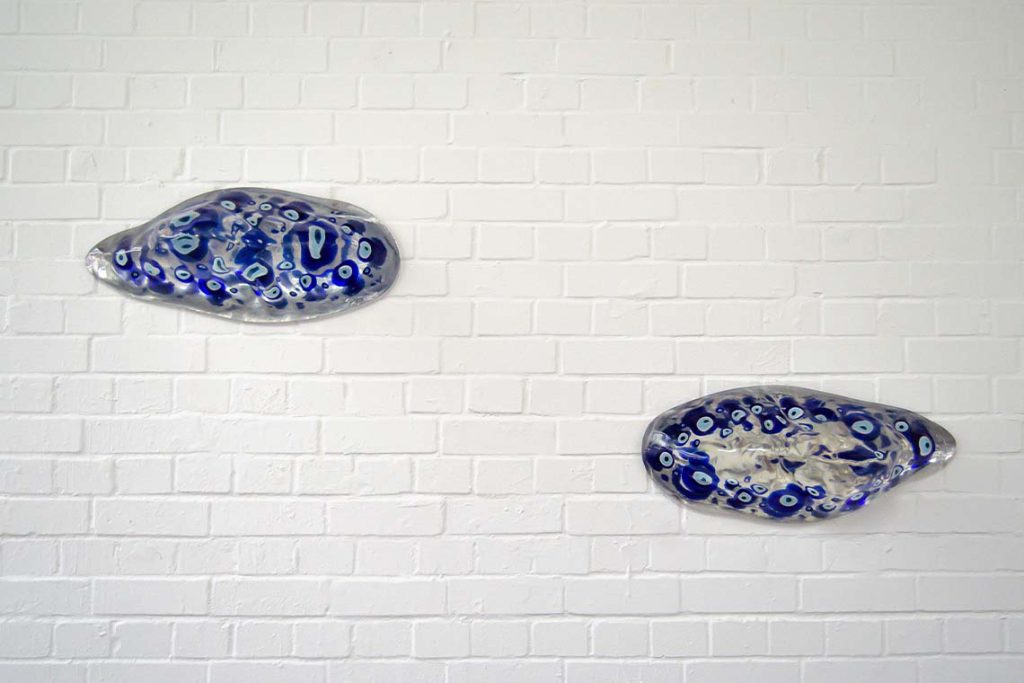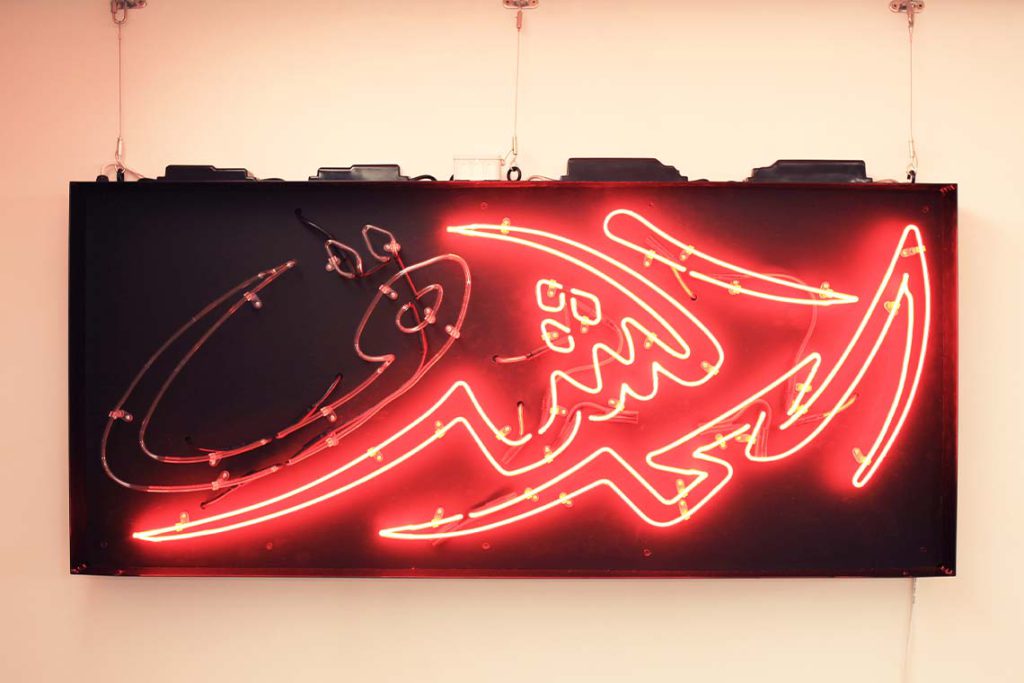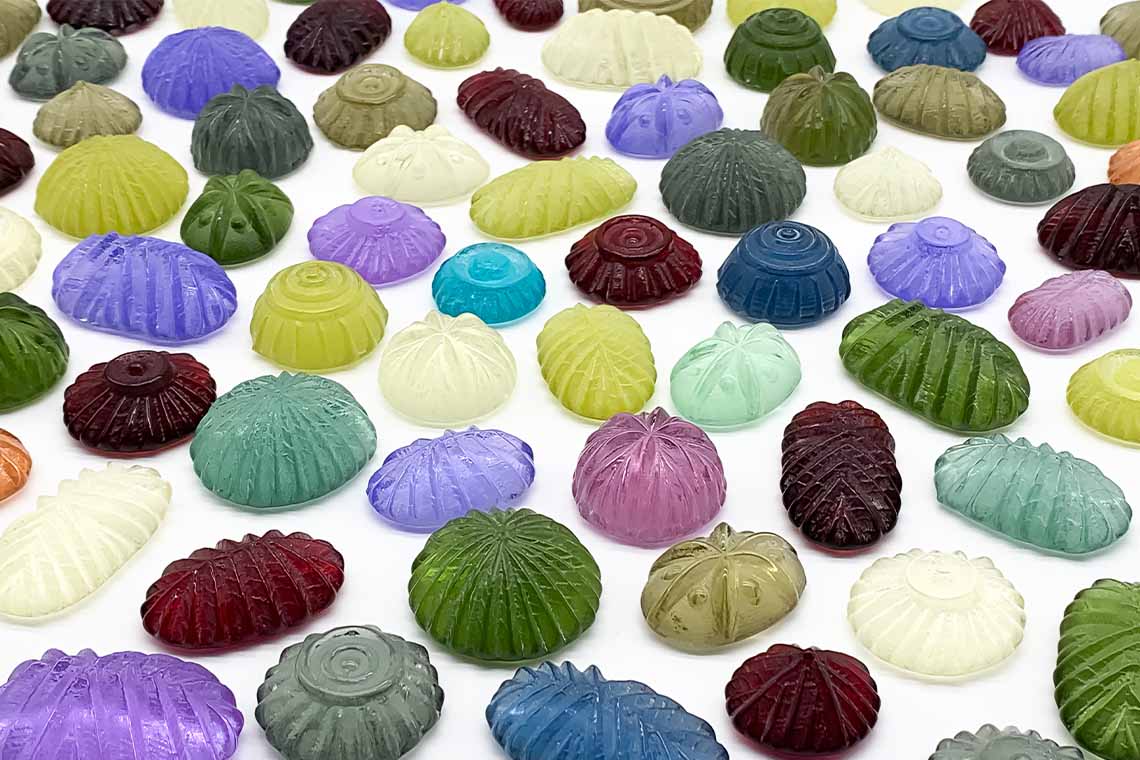Ramzi Mallat’s Fault Lines at P21 Gallery in London examines the fragmented interconnectedness of Middle Eastern societies.
On a gloomy London evening, I found myself immersed in Middle Eastern warmth as the smell of ma’amoul (date cookies), tea and juices wafted out of P21 Gallery in the city’s busy King Cross area. It was the opening night of Lebanese artist Ramzi Mallat’s Fault Lines, a thought-provoking exhibition that questions the fractures within contemporary Southwest Asian and North African (SWANA) societies. Curated by Kirsty Flockhart, the show blurs the lines between identity, politics and geography.
One was immediately confronted by warped glass evil eyes, titled Billow and Behold (2023), on entering the main space. Set in resin, the glass charms are shaped to mimic two shut eyes and continued to follow visitors as they moved through the space, a reminder of the political and social stakes tackled by Mallat throughout the exhibition.
To the right of Billow and Behold is a grid of Arabic coffee cups, aptly titled Intimacy in Anonymity (2018), coated in the dried grounds that are a staple of community building in Lebanese society. The cups are placed outside of their natural setting – informal cafés, fortune-telling grandmothers and social interaction were notably missing. Each coffee cup represents a connection, an interaction, and Mallat demands us to read into these invisible communities through the dried grounds. Mallat offered pedestrians throughout Lebanon a cup of coffee; each empty cup was brought together to create Intimacy in Anonymity. Now in London, scrutinizing these ceramic cups that were actually made in China, the grid-like conglomerate of futures past and present begs a consideration of global cultural, economic and social interdependence.

While half of P21’s main room features work that draws on Lebanese heritage and tradition, Mallat moves seamlessly past fractures that divide generations across borders and diasporas. Opposite Intimacy in Anonymity is Shock & Awe (2022), a flickering neon sign in the artist’s handwriting. It illustrates a familiar Arabic saying that translates to “Magic of the East”, though the translation becomes “Magic of Evil” as the last letter flickers in and out of recognition. Shock & Awe was also represented in a series of prints lining the hallway, with the last letter embossed onto paper, with only traces of ink. At first glance, the neon sign looks like it could be hanging in a crowded street, its flickering reminiscent of a sign well established in its place but not touched for years. Yet, the flicker instils a new meaning to both phrases, a critical linguistic examination of geopolitics and perception. The Middle East, articulated through centuries of Orientalism, was regarded as exotic and alluring, while the geopolitics of the past century have turned the region into one that the West views as negative and dangerous. Mallat’s calligraphy stretches time, interrogating representations of the Middle East from the outside.
Downstairs I came across Not Your Martyr (2023), a glass case filled with colourful glass ma’amoul, the very dessert I had held in my hand soon after arriving at P21. Mallat presents these vibrant glass works in commemoration of the victims of the 2020 Beirut explosion, a calamity that shook Lebanese society while also emblematising the structural political and economic issues within the country. One is struck by the simultaneous fragility and durability of the piece, a migrating memorial that forces the viewer to confront events of the past in an environment of perpetual forgetting and amnesia.
Tucked into a small room right across from Not Your Martyr was Mallat’s only film piece in the show: Sobhiye (2022). Undulating between urban chaos and rural serenity, it tracks five people in different parts of Lebanon as they engage in the daily struggle of life amid economic crises, social hardship and political corruption. Breaking apart the rural/urban divide so prevalent throughout the Middle East, the film centres politics as the sobering sinew that connects Lebanese society.

Spread across P21’s two floors, Fault Lines blends cultural heritage, political commentary and methods of resistance across time and geography. Carefully positioned within the Lebanese context, the works are deeply intimate, illuminating the care Mallat puts into each piece, the physical and emotional labour evident in each construction. Every piece is tangible; the viewer is forced to interact with each work in three dimensions, whether it be looking down at glass ma’amoul shapes, staring at coffee cups or looking around a projected sculpture of Lebanon’s parliament building.
As I left the opening, I reflected on the interconnectedness of art from the SWANA region. Mallat presented an exceptional offering of works that are as personal as they are political, as rooted in Lebanon as they are applicable to the wider Middle East. Much of the cultural heritage referenced in the works is found throughout the Levant and beyond, a reminder that struggles for justice, freedom and community are not isolated events. Indeed, one of the strongest offerings of Fault Lines was this broad impact: communities across the Middle East can feel interconnected solidarity across the unnatural borders and fault lines that divide so many in the region.



